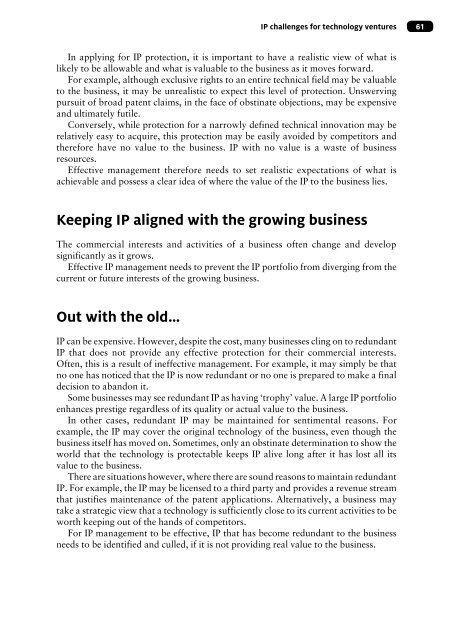The growing business handbook : inspiration and advice ... - Sparkler
The growing business handbook : inspiration and advice ... - Sparkler
The growing business handbook : inspiration and advice ... - Sparkler
You also want an ePaper? Increase the reach of your titles
YUMPU automatically turns print PDFs into web optimized ePapers that Google loves.
IP challenges for technology ventures<br />
61<br />
In applying for IP protection, it is important to have a realistic view of what is<br />
likely to be allowable <strong>and</strong> what is valuable to the <strong>business</strong> as it moves forward.<br />
For example, although exclusive rights to an entire technical field may be valuable<br />
to the <strong>business</strong>, it may be unrealistic to expect this level of protection. Unswerving<br />
pursuit of broad patent claims, in the face of obstinate objections, may be expensive<br />
<strong>and</strong> ultimately futile.<br />
Conversely, while protection for a narrowly defined technical innovation may be<br />
relatively easy to acquire, this protection may be easily avoided by competitors <strong>and</strong><br />
therefore have no value to the <strong>business</strong>. IP with no value is a waste of <strong>business</strong><br />
resources.<br />
Effective management therefore needs to set realistic expectations of what is<br />
achievable <strong>and</strong> possess a clear idea of where the value of the IP to the <strong>business</strong> lies.<br />
Keeping IP aligned with the <strong>growing</strong> <strong>business</strong><br />
<strong>The</strong> commercial interests <strong>and</strong> activities of a <strong>business</strong> often change <strong>and</strong> develop<br />
significantly as it grows.<br />
Effective IP management needs to prevent the IP portfolio from diverging from the<br />
current or future interests of the <strong>growing</strong> <strong>business</strong>.<br />
Out with the old…<br />
IP can be expensive. However, despite the cost, many <strong>business</strong>es cling on to redundant<br />
IP that does not provide any effective protection for their commercial interests.<br />
Often, this is a result of ineffective management. For example, it may simply be that<br />
no one has noticed that the IP is now redundant or no one is prepared to make a final<br />
decision to ab<strong>and</strong>on it.<br />
Some <strong>business</strong>es may see redundant IP as having ‘trophy’ value. A large IP portfolio<br />
enhances prestige regardless of its quality or actual value to the <strong>business</strong>.<br />
In other cases, redundant IP may be maintained for sentimental reasons. For<br />
example, the IP may cover the original technology of the <strong>business</strong>, even though the<br />
<strong>business</strong> itself has moved on. Sometimes, only an obstinate determination to show the<br />
world that the technology is protectable keeps IP alive long after it has lost all its<br />
value to the <strong>business</strong>.<br />
<strong>The</strong>re are situations however, where there are sound reasons to maintain redundant<br />
IP. For example, the IP may be licensed to a third party <strong>and</strong> provides a revenue stream<br />
that justifies maintenance of the patent applications. Alternatively, a <strong>business</strong> may<br />
take a strategic view that a technology is sufficiently close to its current activities to be<br />
worth keeping out of the h<strong>and</strong>s of competitors.<br />
For IP management to be effective, IP that has become redundant to the <strong>business</strong><br />
needs to be identified <strong>and</strong> culled, if it is not providing real value to the <strong>business</strong>.








